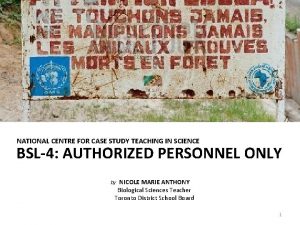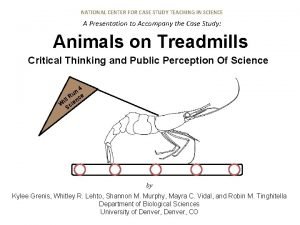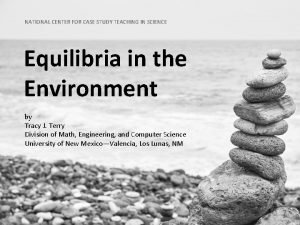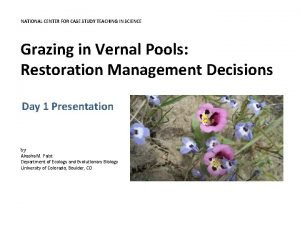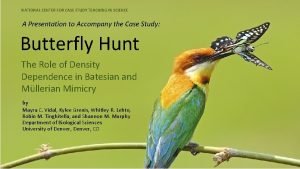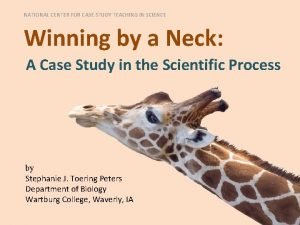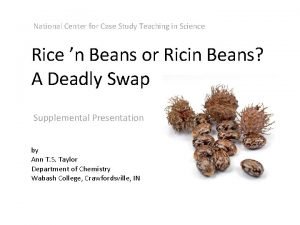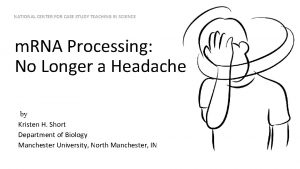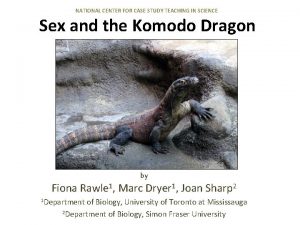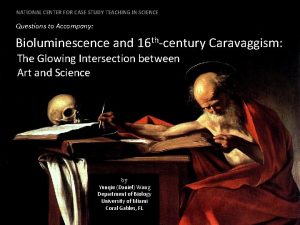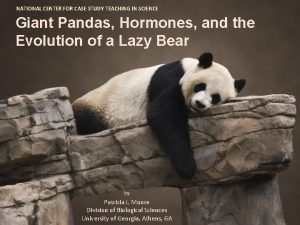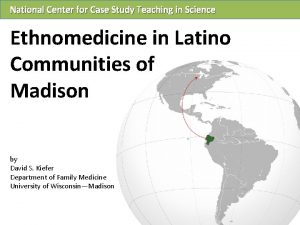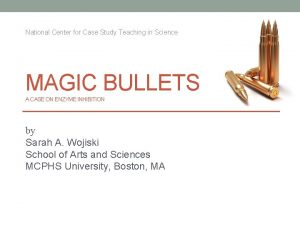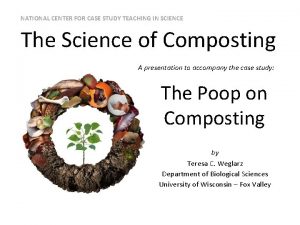NATIONAL CENTER FOR CASE STUDY TEACHING IN SCIENCE
















- Slides: 16

NATIONAL CENTER FOR CASE STUDY TEACHING IN SCIENCE Winning by a Neck: A Case Study in the Scientific Process by Stephanie J. Toering Peters Department of Biology Wartburg College, Waverly, IA

The Scientific Process 1. 2. 3. 4. 5. Observation Hypothesis Development Design a Scientific Study Make Predictions Collect Data and Draw Conclusions 2

Giraffes have long necks … Stage 1: Observation 3

Why do giraffes have long necks? Develop at least two hypotheses that can answer the question above. Stage 2: Hypothesis Development 4

Hypothesis 1 Giraffes have long necks in order to take advantage of high food sources. How can you test this hypothesis? Stage 3: Design a Scientific Study 5

Experiment 1: Feeding Habits Field observations of giraffe feeding (Young and Isbell 1991) 15 minute samples (n=39) Record • plant species • plant height • # bites per eating bout • time per eating bout • giraffe identity What do you expect to see based on your hypothesis? Stage 4: Make Predictions 6

Experiment 1: Feeding Habits 30 Percent feeding at different feeding heights for adult male and females giraffes. Female Percent Feeding 25 Male 20 Adult giraffes are 4. 5 -5. 5 m tall. 15 (based on Young and Isbell 1991) 10 5 0 0 1 2 3 4 Feeding Height (m) 5 6 Do these data support your hypothesis? Stage 5: Collect Data and Draw Conclusions 7

Experiment 2: Feeding Habits Field observations of giraffe feeding (Leuthold and Leuthold, 1972) Performed in both green and dry seasons For each time a giraffe feeds (n=3124), record • plant species • browsing height: low (<2 m) or high (>2 m) What do you expect to see based on your hypothesis? Stage 4: Make Predictions 8

Experiment 2: Feeding Habits 100 Percent feeding at low heights. Every feeding observations was classified as low (<2 m) or high (>2 m). Percent 80 60 (based on Leuthold and Leuthold 1972) 40 20 0 Green Season Dry Season Overall Do these data support your hypothesis? Stage 5: Collect Data and Draw Conclusions 9

A New Direction … As you observed giraffe feeding, you also noticed that males would frequently spar (and sometimes fight) by swinging their heads and necks at each other. Develop a new hypothesis based on these observations. Propose an experiment to test your hypothesis. Stage 2: Hypothesis Development Stage 3: Design a Scientific Study 10

Hypothesis 2 Male giraffes have long necks in order to compete for females. Experiment 3: Field observations of giraffes (Pratt and Anderson, 1985) Classify all males as • A (large, thick necks, and massive horns) • B (thicker necks and longer horns than C) • C (young, narrow necks, small horns) Record dominance interactions between males and courting behavior with females. What do you expect to see based on your hypothesis? Stage 4: Make Predictions 11

Experiment 3: Dominance Interactions 40 A Bulls 35 B Bulls Displaced Bulls 30 C Bulls 25 Number of bulls displaced by A, B, and C bulls. A bulls are the largest, B bulls are intermediate, and C bulls are the smallest. The ability of a bull to displace another bull indicates dominance. 20 15 10 (based on Pratt and Anderson 1985) 5 0 A Bull B Bull Dominant Bull C Bull Do these data support your hypothesis? Stage 5: Collect Data and Draw Conclusions 12

Experiment 3: Dominance Interactions Number of bulls observed courting cows. A bulls are the largest, B bulls are intermediate, and C bulls are the smallest. 12 Percent Courting Cows 10 8 6 (based on Pratt and Anderson, 1985) 4 2 0 A Bulls Bull Type C Bulls Do these data support your hypothesis? Stage 5: Collect Data and Draw Conclusions 13

Why do giraffes have long necks? • Hypothesis 1: Giraffes have long necks in order to take advantage of high food sources. NOT SUPPORTED • Hypothesis 2: Male giraffes have long necks in order to compete for females SUPPORTED Stage 5: Draw Conclusions 14

Conclusion • Hypotheses need to be tested to determine whether they should be accepted. • Hypotheses are not always correct, but rejecting a hypothesis allows you to move on to the next hypothesis. • A hypothesis that is tested in many ways and is supported by many experiments is elevated to a theory. 15

Summary Questions 1. What have you learned about the scientific process in this exercise? 2. What is the role of experiments/observations in the process of science? 3. How does a hypothesis help move science forward, even if it is not supported by the evidence? 16
 National center for case study teaching in science
National center for case study teaching in science National center for case study teaching in science
National center for case study teaching in science National center for case study teaching in science
National center for case study teaching in science National center for case study teaching in science
National center for case study teaching in science National center for case study teaching in science
National center for case study teaching in science National center for case study teaching in science
National center for case study teaching in science National center for case study teaching in science
National center for case study teaching in science Best worst and average case
Best worst and average case Project failure case study
Project failure case study My favourite science
My favourite science Microteaching is a scaled down teaching
Microteaching is a scaled down teaching Iso 22301 utbildning
Iso 22301 utbildning Novell typiska drag
Novell typiska drag Tack för att ni lyssnade bild
Tack för att ni lyssnade bild Ekologiskt fotavtryck
Ekologiskt fotavtryck Varför kallas perioden 1918-1939 för mellankrigstiden?
Varför kallas perioden 1918-1939 för mellankrigstiden? En lathund för arbete med kontinuitetshantering
En lathund för arbete med kontinuitetshantering
